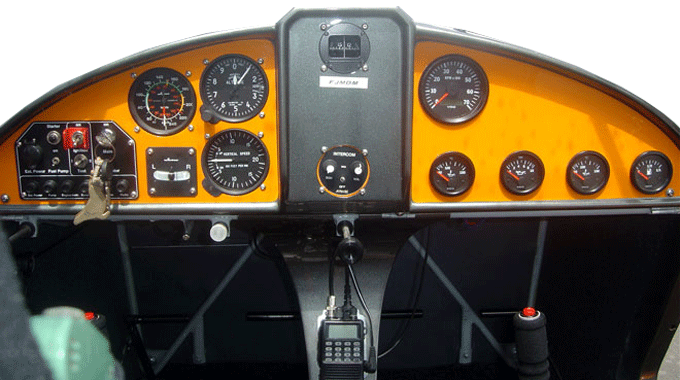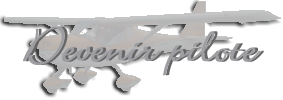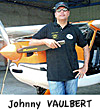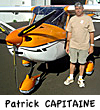



Conditions for obtaining
For the ultralight pilot, regardless of class, you must:
 to be 15 years old ;
to be 15 years old ;
 satisfy a theoretical type QCM, held once every two months by the aeronautical district nearest your home, or ADP (Aéroports de Paris);
satisfy a theoretical type QCM, held once every two months by the aeronautical district nearest your home, or ADP (Aéroports de Paris);
 be issued a permit to fly alone authorized by an instructor, after practical training (20 to 30 hours in general).
be issued a permit to fly alone authorized by an instructor, after practical training (20 to 30 hours in general).
Equivalences
Since the order of 4 May 2000, there is no equivalence.
If you hold a pilot plane, helicopter, glider or free balloon, or a foreign license, you are only exempt from certificate of competency common theoretical ULM.
It is appropriate to the theoretical specific class chosen ULM and practice with an instructor.
The passenger carriage
After sufficient experience as a pilot car, you pass a second test flight with a microlight instructor, according to a federal program in order to obtain authorization to carry a passenger.

We propose you to discover the ULM through the frequently asked questions ...
1. What characterizes an ultralight?
2. Should a patent for an ultralight pilot?
3. What is the duration of training to obtain the patent?
4. An ultralight pilot can fly wherever he wants?
5. An ultralight can take off and land anywhere?
6. At what altitude an ultralight can fly?
7. What will happen if the engine stops?
8. Is an ultralight less safe than other aircraft of tourism?
1. What characterizes an ultralight?
The term ultralight is used to designate a motorized ultralight glider glider.
This is an aircraft, ie a device that flies, with special features:
 maximum two-seater aircraft.
maximum two-seater aircraft.
 maximum takeoff weight, all inclusive (machine, passengers, fuel, baggage, etc ...) to 300 kg for a single or 450 kg for a two-seater. An excess of 5% to 10% is permitted for the carriage of certain equipment clarified by regulations (parachute).
maximum takeoff weight, all inclusive (machine, passengers, fuel, baggage, etc ...) to 300 kg for a single or 450 kg for a two-seater. An excess of 5% to 10% is permitted for the carriage of certain equipment clarified by regulations (parachute).
 engine having a maximum continuous power of 45 kW (61 hp) for a single, and 60 KW (82 HP) for a two-seater, with exceptions in some classes.
engine having a maximum continuous power of 45 kW (61 hp) for a single, and 60 KW (82 HP) for a two-seater, with exceptions in some classes.
 minimum landing speed of 65 km / h.
minimum landing speed of 65 km / h.
 Back to questions
Back to questions
2. Should a patent for an ultralight pilot?
Yes, we must hold a microlight pilot's license, specific to each class of ULM, issued by the Ministry of Transportation at the conclusion of an examination that includes:
 a theoretical part on different knowledge areas such as security, regulations, navigation, meteorology and aérologie, flight mechanics ...
a theoretical part on different knowledge areas such as security, regulations, navigation, meteorology and aérologie, flight mechanics ...
 a practical demonstration of the candidate's capacity to be able to operate an ultralight grade.
a practical demonstration of the candidate's capacity to be able to operate an ultralight grade.
An additional, controlled by a flight test, is required to obtain a permit to carry passengers.
 Back to questions
Back to questions
3. What is the duration of training to obtain the patent?
This period varies according to the class of ULM ... and ease of learning of the student pilot.
For example, the training program established by FFPLUM is 50 lessons, approximately 25 hours of flight training for a patent "multi".
 Back to questions
Back to questions
4. An ultralight pilot can fly wherever he wants?
Like all flying machines, a microlight is subject to the rules of air traffic.
It is further limited to the mode called "Flight", which means it can not fly that day (30 minutes before sunrise to 30 minutes after sunset), outside of clouds, with a minimum visibility defined by the regulations. The pilot must always have sight of the ground.
It can move freely across airspace known as "controlled area" for which there is no specific set by the Air Navigation.
Other areas known as "controlled spaces" are subject to authorization to enter. Examples of the areas located around or near the airfield in the air corridors to commercial airliners, in some military areas ...
Finally, there are areas where penetration is banned, temporarily or permanently (some military areas, or nuclear power plants for example).
 Back to questions
Back to questions
5. An ultralight can take off and land anywhere?
Unlike aircraft, an ultralight can take off and land outside the airfields. This is one of its main attractions.
A microlight may occasionally take off and land on a site with characteristics sufficient (open terrain, 200 to 300m long and 20 wide) if the authorization of the owner or person entitled, and to warn the mayor of the town. Such land is called "platform casual".
If the land is used regularly, it is considered "permanent platform" and should be an order prefectural authorization of use.
Microlights may, except in special cases, take off and land at airfields freely "uncontrolled" (where many airports with low traffic), but must seek permission at airfields' controlled '.
In case of emergency landing, the pilot's priority is to ensure the safety of the flight, including landing, when he chose the field that seemed best suited for this maneuver.
 Back to questions
Back to questions
6. At what altitude an ultralight can fly?
Procedures outside off and landing, the regulation imposes a minimum height above ground, without any artificial barrier or gathering of people, 500 feet (approx. 150 m). The nature of "barriers" over the (factory, town, gathering people ...) results in high minimum specific overflight.
The regulatory maximum altitude is 19 500 feet (about 5 950 m).
In practice, the limit depends on the qualities of the machine: the higher up, air is less dense and therefore able to "bear" aircraft which must then develop more power to continue to rise. Given its characteristics of strength and bearing surface, there are for each device and a "theoretical ceiling", which often ranges between 4000 m and 5000 m, from which it rises more. This limit is quite sufficient for our form of aviation.
Most ULM vary between 300m and 1,500 m above ground level, height to enjoy the scenery.
 Back to questions
Back to questions
7. What will happen if the engine stops?
By design, the ultralight is an aircraft capable of gliding.
Therefore, if the engine stops, the pilot can maneuver his ULM for the landing on an improvised landing zone (procedure known as "raised in the countryside" as the official language, or "go to the cows" in the language of drivers).
The engine failure is not a cause of accidents in a microlight.
This hazard is one of the incidents that may occur at any time of the flight. That is why all drivers during their training, learn to put his aircraft engine off.
For safety, a driver shall take the flight to be always close to land to an emergency landing, which in addition to fly at a height sufficient flight (500 m 300A / ground minimum) to conduct this operation with maximum safety.
 Back to questions
Back to questions
8. Is an ultralight less safe than other aircraft of tourism?
Any form of theft involves an element of risk, regardless of the aircraft on which we fly. The flight is an activity that must be performed with great precision, in strict observance of the rules and being extremely sensitive to weather conditions.
The statistics today show that ULM is no more dangerous than other aeronautical activities. ULM but still suffers from a negative image inherited from infancy and approximations that prevailed in the early 1980s, when the activity is now fully mature.
Approximately 90% of the ULM is produced by those professionals who master the rules of art. A modern, whether technology tubes and canvas' or 'composite', if properly maintained and used according to manufacturer's requirements, provides a level of security comparable to that of a light aircraft.
The ability to easily be able to ask an ultralight (see § 7) in fact an element of security.
Similarly, the low mass of the flying ULM (450 kg) can be fitted with a parachute relief in case of serious difficulty making the aircraft uncontrollable, may return to the ground and the whole machine crew .
The analysis of the causes of accidents frequently shows that unfortunately, as road traffic, it is often the pilot is at stake. Flights boring, acrobatics, insufficient weather, fatigue ... are often the cause of accidents could be avoided.
 Back to questions
Back to questions

